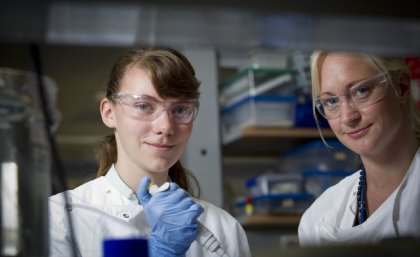
By Maggie Hardy
When high school physics teacher Moses Rifkin wrote a recent blog post on “Teaching Social Justice in the Physics Classroom,” he ignited a new round of conversation about white privilege and the kinds of skills scientists need. Rifkin outlined how he incorporates into his teaching a unit on “Who does physics, and why?” to highlight the lack of diversity in science, particularly physics.
The problem isn’t new and it isn’t going away by itself. But it is getting more and more attention. The United States National Science Foundation (NSF) recently released a report, “Pathways to Broadening Participation in response to the Committee on Equal Opportunities in Science and Engineering 2011–2012 Recommendation,” intended to “build on best practices and offer new approaches" that would “increase participation in STEM [Science, Technology, Engineering and Math] from underrepresented groups.” This isn’t the first initiative of its kind for the agency; since 1980, NSF has had a mandate to increase the participation of women and minorities in science and engineering.
A diverse science and engineering workforce is critical for innovation, entrepreneurism and a competitive national economy.

Scope of the problem
Although women earn about half the bachelor’s degrees awarded in biology and chemistry, they are underrepresented in all other STEM disciplines – mathematics, computer science, earth sciences, engineering and physics. Women are half the population, but hold only 28% of science and engineering jobs.
Native American and Alaska Native students earn bachelor’s degrees in STEM fields at about the same rate as white students (21% for women and 27% for men), but are not employed in STEM fields proportionally. The number of black and Hispanic students earning degrees in STEM fields is lower than the national average, and their employment in STEM – once again – isn’t proportional. We train students in STEM fields, but ultimately they leave the carousel that is employment in research.
The issues with relying largely on one demographic group to do science are many, particularly when that group does not reflect the population. Research has shown that “promoting diversity not only promotes representation and fairness but may lead to higher quality science.” Policies that increase equity are often good for everyone – here is a recent example showing this using standardized math test scores.
Increasing the diversity in science opens up the possibility of stable, high-paying jobs in STEM fields to more Americans. Pulling from the entire population, including traditionally underrepresented communities, provides a more robust base for economic innovation and the knowledge-intensive jobs of the future.
Equity is good for business, too. Although women in technology are some of the highest performing entrepreneurs, men receive 2.8 times more startup capital.
Where do we need to be?
The National Science Foundation is a key player for academics, as its budget ($7.3 billion for 2015) funds approximately 24% of all federally supported basic research. NSF uses a peer-based merit review system to invest in basic research that lays the foundation for important discoveries, as well as applied research that provides innovative fodder for our economy. Its prominence as a funding source for colleges and universities is part of the reason its initiatives are important for many researchers.
According to the new diversity report, “the ultimate goal is to have participation in STEM fields mirror the population of the Nation.” Specifically, that means we need to focus on recruiting and retaining the best talent from currently under-represented groups: blacks, Latinos and indigenous communities, including Native Americans, Alaska Natives, Native Hawaiians and other Pacific Islanders. Based on recent estimates, by 2044 the United States will be a majority-minority country, so to have the research workforce mirror the population we need a clear path to retain people in research positions.
There is a need for a clear, well supported career pathway for early- and mid-career researchers, with an emphasis on retaining traditionally underrepresented groups. And NSF isn’t the only institution focusing on this issue. The National Institutes of Health, the American Association for the Advancement of Science, and the scientific journals Nature and Science) have all discussed the problematic lack of diversity in science. In 2013 the White House released a 5-year strategic plan for STEM Education, which emphasized creating a diverse STEM workforce.
How do we get there?
NSF has pulled together the most current evidence-based strategies to increase diversity in STEM. The report groups proposed interventions into the following six categories.
- Financial support, primarily geared toward supporting college students
- Professional and social support, with renewed emphasis on the importance of learning in both formal and informal settings
- Mentoring, to provide one-on-one career advice and role models to show the path, as well as the destination
- Research experience, critical to develop and sustain interest in STEM education and careers
- Combating stereotype threat, the fear of “confirming a negative stereotype about one’s group (e.g., women aren’t good at math)"
- Community building, combining all the above ideas, adding institutional commitment and support for building scientific capacity. Setting and measuring the achievement of specific goals, and accountability when they are or are not met, is key
Most importantly, what is the career pathway that will take students on to careers in science and engineering research? The total number of postdoctoral researchers (those who have recently earned their PhD) at federally funded research centers dropped between 2012 and 2013; the loss was more pronounced for women (-13%) than for men (-4%).
NSF could expand postdoctoral fellowship programs, implementing some designed to foster collaboration with industry. They could increase funding for the Centers for Research Excellence in Science and Technology, which earmarks resources for minority-serving institutions and historically black colleges and universities.
The bottom line
The research community has made it clear that the reasons for attrition need to be better understood. But more importantly, we need to stem the tide of highly specialized, highly trained people leaving research.
Non-scientists – including journalists and media personalities – who comment on what skills scientists need to be successful are often terrifically far off the mark, but could be influencing the next generation of potential STEM workers. Scientists believe we need to broaden participation so we have the most creative problem-solvers trained and ready to work. Recognizing and rectifying inequity is part of our core work, because it helps us do better research. Researchers working at the cold face of problems that didn’t even exist ten years ago realize we need a diverse range of scientists to pull from to be competitive, and this is exactly what the report from NSF illustrates.
If we really want the best scientists doing research, as we say we do, then we must have a hiring pool that reflects the diversity of the nation. Our best scientists aren’t getting any younger, and we need support for early-career researchers in academic, industry and government positions now.
![]() This article was originally published on The Conversation.
This article was originally published on The Conversation.
The views expressed in this article are not necessarily those of The University of Queensland.
.jpg)










